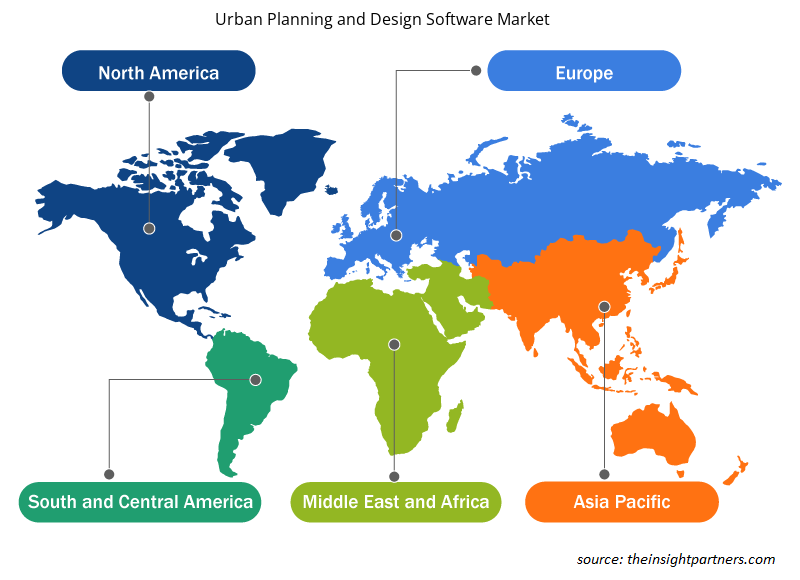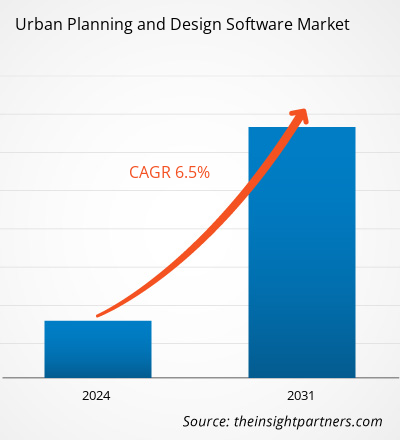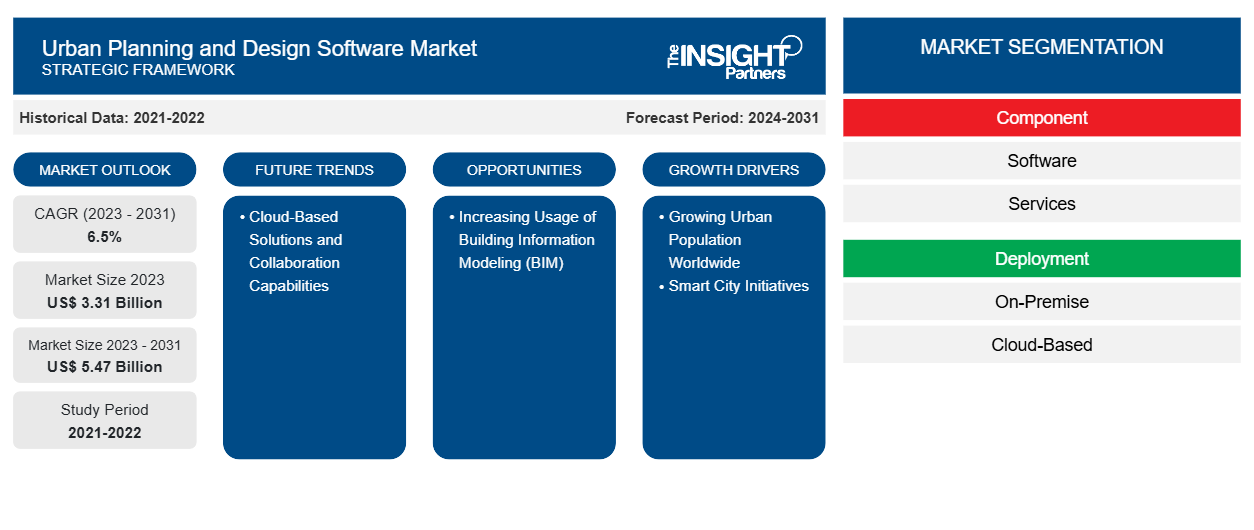Si prevede che la dimensione del mercato del software di progettazione e pianificazione urbana raggiungerà i 5,47 miliardi di dollari entro il 2031, rispetto ai 3,31 miliardi di dollari del 2023. Si prevede che il mercato registrerà un CAGR del 6,5% nel periodo 2023-2031. La crescita della popolazione urbana in tutto il mondo e le iniziative per le città intelligenti rimarranno probabilmente tendenze chiave nel mercato.
Analisi di mercato del software di progettazione e pianificazione urbana
Le piattaforme basate su cloud stanno diventando sempre più popolari come risultato della trasformazione digitale, grazie alla loro facile implementazione e ai costi più bassi. Le piattaforme basate su cloud sono anche accessibili agli utenti finali grazie all'infrastruttura Internet che è stata costruita nelle nazioni industrializzate e sta crescendo in numerose nazioni in via di sviluppo. L'hosting sicuro di dati importanti, la sicurezza e la scalabilità migliorate e il rapido recupero dei file sono alcuni vantaggi del software di progettazione e pianificazione urbana basato su cloud. Una piattaforma di hosting cloud privata o condivisa viene utilizzata per archiviare i backup. Pertanto, i dati vitali del server possono essere prontamente recuperati dalle organizzazioni. Inoltre, i dati sono facilmente accessibili da qualsiasi posizione con accessi sicuri e una connessione Internet affidabile . Inoltre, la riduzione dei costi di riparazione e manutenzione e l'aumento della soddisfazione del cliente sono i software di progettazione e pianificazione urbana basati su cloud.
Panoramica del mercato del software di progettazione e pianificazione urbana
Il software per la pianificazione e la progettazione urbana viene utilizzato per creare modelli 3D di contesti urbani e sviluppare layout urbani. Architetti e urbanisti utilizzano il software per la pianificazione e la progettazione urbana per visualizzare come i loro piani potrebbero apparire nel mondo reale. Gli urbanisti possono migliorare le loro raccomandazioni per la pianificazione urbana e creare layout urbani conformi alle leggi locali di zonizzazione producendo visualizzazioni 3D. Gli utenti possono importare automaticamente strutture del mondo reale nel loro software di pianificazione e progettazione urbana integrandolo con il software GIS. Gli utenti traggono vantaggio dal risparmio di tempo e gli urbanisti sono in grado di costruire attorno all'infrastruttura esistente di un ambiente urbano.
Personalizza questo report in base alle tue esigenze
Riceverai la personalizzazione gratuita di qualsiasi report, comprese parti di questo report, o analisi a livello nazionale, pacchetto dati Excel, oltre a usufruire di grandi offerte e sconti per start-up e università
-
Scopri le principali tendenze di mercato in questo rapporto.Questo campione GRATUITO includerà analisi di dati che spaziano dalle tendenze di mercato alle stime e alle previsioni.
Driver e opportunità del mercato del software per la pianificazione e la progettazione urbana
La crescita della popolazione urbana in tutto il mondo favorisce il mercato
Secondo la Banca Mondiale, attualmente circa il 56% della popolazione mondiale, che ammonta a 4,4 miliardi di abitanti, risiede nelle città. Si prevede che questa tendenza persisterà, con la popolazione urbana che raddoppierà le sue dimensioni attuali entro il 2050, anno in cui quasi 7 persone su 10 vivranno nelle città. Si prevede che la continua crescita della popolazione urbana mondiale creerà la necessità di sviluppare nuove strutture, tra cui edifici commerciali e residenziali . Di conseguenza, ci sarà una richiesta di software di progettazione e pianificazione urbana per facilitare la costruzione di queste infrastrutture. Ad esempio, aziende come SketchUp (Trimble Inc.) offrono software di progettazione urbana che aiutano i pianificatori nei loro compiti sfruttando la progettazione assistita da computer (CAD) e gli strumenti di geolocalizzazione all'interno del toolkit del pianificatore urbano SketchUp, consentendo loro di passare dai modelli concettuali alle proposte.SketchUp (Trimble Inc.) offer urban design software that aids planners in their tasks by leveraging computer-aided design (CAD) and geolocation tools within the SketchUp city planner's toolkit, enabling them to progress from conceptual models to proposals.
Utilizzo crescente del Building Information Modeling (BIM)
Building Information Modeling (BIM) è una tecnologia all'avanguardia che sta guadagnando sempre più terreno nella pianificazione urbana. Comporta lo sviluppo di una rappresentazione digitale di un progetto edilizio o infrastrutturale, contenente informazioni dettagliate sulla sua progettazione, costruzione e manutenzione. Questi dati vengono conservati in un database centrale a cui possono accedere le diverse parti coinvolte nel progetto dall'inizio alla fine. Attraverso l'uso del BIM, gli urbanisti ottengono una visione completa e aggiornata di un progetto, con conseguenti minori errori, una migliore comunicazione e processi di costruzione più rapidi. Inoltre, il BIM garantisce che i progetti soddisfino gli standard più elevati e siano conformi a tutti i mandati normativi.
Analisi della segmentazione del rapporto di mercato del software di progettazione e pianificazione urbana
I segmenti chiave che hanno contribuito alla derivazione dell'analisi di mercato del software di progettazione e pianificazione urbana sono i componenti, l'implementazione e l'applicazione.
- In base al componente, il mercato è segmentato in software e servizi. Il segmento software ha detenuto una quota di mercato significativa nel 2023.
- In termini di distribuzione, il mercato è diviso in on-premises e basato su cloud. Il segmento on-premises ha detenuto una quota sostanziale del mercato nel 2023.
- In base all'applicazione, il mercato è segmentato in architetti, urbanisti e dipartimenti creativi. Il segmento degli architetti ha detenuto una quota di mercato significativa nel 2023.
Analisi della quota di mercato del software di progettazione e pianificazione urbana per area geografica
L'ambito geografico del rapporto sul mercato dei software per la progettazione e la pianificazione urbana è suddiviso principalmente in cinque regioni: Nord America, Asia Pacifico, Europa, Medio Oriente e Africa, e Sud e Centro America.
Si prevede che il Nord America deterrà una quota significativa di fatturato del mercato dei software di progettazione e pianificazione urbana. Secondo il Programma delle Nazioni Unite per lo sviluppo, oltre il 60% della popolazione mondiale vive in città, di cui oltre il 70% è costituita da popolazione attiva; inoltre, l'80% del valore economico mondiale è generato nelle città. Le iniziative per le città intelligenti comportano l'adozione di varie tecnologie intelligenti, tra cui software di progettazione e pianificazione urbana, che rendono le operazioni più efficienti dal punto di vista energetico e sostenibili, oltre a ridurre al minimo le emissioni di carbonio. Pertanto, si prevede che le crescenti iniziative nei progetti di città intelligenti creeranno varie opportunità di crescita del mercato durante il periodo di previsione.
Approfondimenti regionali sul mercato del software di progettazione e pianificazione urbana
Le tendenze regionali e i fattori che influenzano il mercato del software di progettazione e pianificazione urbana durante il periodo di previsione sono stati ampiamente spiegati dagli analisti di Insight Partners. Questa sezione discute anche i segmenti e la geografia del mercato del software di progettazione e pianificazione urbana in Nord America, Europa, Asia Pacifico, Medio Oriente e Africa e America centrale e meridionale.

- Ottieni i dati specifici regionali per il mercato del software di progettazione e pianificazione urbana
Ambito del rapporto di mercato del software di progettazione e pianificazione urbana
| Attributo del report | Dettagli |
|---|---|
| Dimensioni del mercato nel 2023 | 3,31 miliardi di dollari USA |
| Dimensioni del mercato entro il 2031 | 5,47 miliardi di dollari USA |
| CAGR globale (2023-2031) | 6,5% |
| Dati storici | 2021-2022 |
| Periodo di previsione | 2024-2031 |
| Segmenti coperti |
Per componente
|
| Regioni e Paesi coperti |
America del Nord
|
| Leader di mercato e profili aziendali chiave |
|
Software di pianificazione e progettazione urbana: attori del mercato Densità: comprendere il suo impatto sulle dinamiche aziendali
Il mercato del software di progettazione e pianificazione urbana sta crescendo rapidamente, spinto dalla crescente domanda degli utenti finali dovuta a fattori quali l'evoluzione delle preferenze dei consumatori, i progressi tecnologici e una maggiore consapevolezza dei vantaggi del prodotto. Con l'aumento della domanda, le aziende stanno ampliando le loro offerte, innovando per soddisfare le esigenze dei consumatori e capitalizzando sulle tendenze emergenti, il che alimenta ulteriormente la crescita del mercato.
La densità degli operatori di mercato si riferisce alla distribuzione di aziende o società che operano in un particolare mercato o settore. Indica quanti concorrenti (operatori di mercato) sono presenti in un dato spazio di mercato in relazione alle sue dimensioni o al valore di mercato totale.
Le principali aziende che operano nel mercato del software per la progettazione e la pianificazione urbana sono:
- Sistemi Bentley Incorporati
- Modello
- CAMMINATA SIMILE
- SchizzoUp
- Impronta urbana
- Urbanismo
Disclaimer : le aziende elencate sopra non sono classificate secondo un ordine particolare.

- Ottieni una panoramica dei principali attori del mercato dei software di progettazione e pianificazione urbana
Notizie e sviluppi recenti sul mercato del software di progettazione e pianificazione urbana
Il mercato del software di progettazione e pianificazione urbana viene valutato raccogliendo dati qualitativi e quantitativi dopo la ricerca primaria e secondaria, che include importanti pubblicazioni aziendali, dati associativi e database. Di seguito sono elencati alcuni degli sviluppi nel mercato del software di progettazione e pianificazione urbana:
- Oggi, presso l'Autodesk University, Autodesk, Inc. (NASDAQ: ADSK) ha annunciato una collaborazione strategica con Epic Games per accelerare le esperienze immersive in tempo reale (RT) in tutti i settori, con un focus iniziale su architettura, ingegneria e costruzioni (AEC).
(Fonte: AUTODESK INC., Comunicato stampa, settembre 2022)
Copertura e risultati del rapporto sul mercato del software di progettazione e pianificazione urbana
Il rapporto "Dimensioni e previsioni del mercato del software di pianificazione e progettazione urbana (2021-2031)" fornisce un'analisi dettagliata del mercato che copre le seguenti aree:
- Dimensioni e previsioni del mercato del software di progettazione e pianificazione urbana a livello globale, regionale e nazionale per tutti i principali segmenti di mercato coperti dall'ambito
- Tendenze del mercato del software di progettazione e pianificazione urbana, nonché dinamiche di mercato quali driver, vincoli e opportunità chiave
- Analisi dettagliata delle cinque forze PEST/Porter e SWOT
- Analisi di mercato del software di progettazione e pianificazione urbana che copre le principali tendenze del mercato, il quadro globale e regionale, i principali attori, le normative e i recenti sviluppi del mercato
- Analisi del panorama industriale e della concorrenza che copre la concentrazione del mercato, l'analisi della mappa di calore, i principali attori e gli sviluppi recenti per il mercato del software di progettazione e pianificazione urbana
- Profili aziendali dettagliati
- Analisi storica (2 anni), anno base, previsione (7 anni) con CAGR
- Analisi PEST e SWOT
- Valore/volume delle dimensioni del mercato - Globale, Regionale, Nazionale
- Industria e panorama competitivo
- Set di dati Excel
Report recenti
Rapporti correlati
Testimonianze
Motivo dell'acquisto
- Processo decisionale informato
- Comprensione delle dinamiche di mercato
- Analisi competitiva
- Analisi dei clienti
- Previsioni di mercato
- Mitigazione del rischio
- Pianificazione strategica
- Giustificazione degli investimenti
- Identificazione dei mercati emergenti
- Miglioramento delle strategie di marketing
- Aumento dell'efficienza operativa
- Allineamento alle tendenze normative























 Ottieni un campione gratuito per - Mercato del software per la pianificazione e la progettazione urbana
Ottieni un campione gratuito per - Mercato del software per la pianificazione e la progettazione urbana